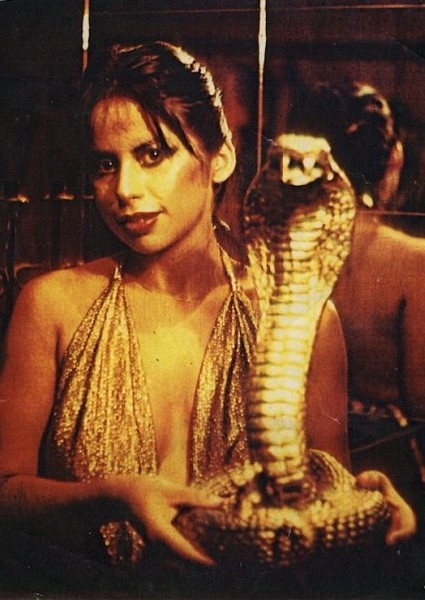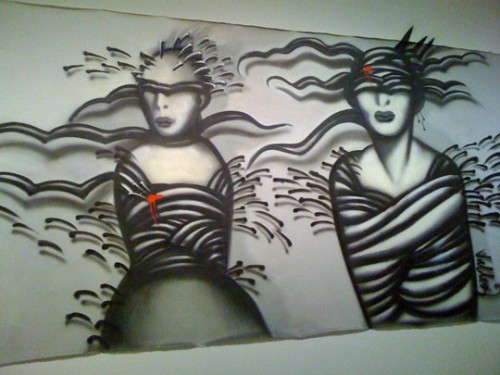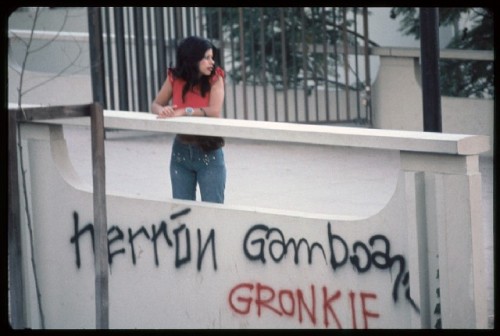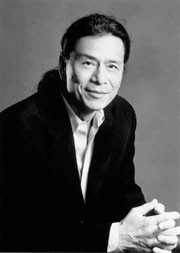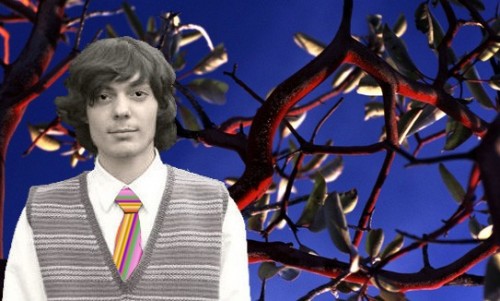Patssi Valdez of Asco Part Three
From No Movies to Carlos Castaneda
By: Patssi Valdez and Charles Giuliano - Mar 21, 2012
Charles Giuliano Let’s talk about the aspect of glamour and fashion. I was interested during the Williams symposium in the discussion of paper fashion by Sean Carillo.
Patssi Valdez You know, I never knew he did that. I’m going to give the credit to Gronk. This is what I remember. The ones who are known for paper fashions are myself and Diane Gamboa. I always give the credit to where I feel it belongs and that’s to Gronk.
We were going to give a performance at a local community center. It was the ugliest center. I remember thinking, yeek, it’s the ugliest center. But it was a free space and we could do this performance. Gronk said “We’re going to meet here and we can’t use anything other than paper.” We said OK and everybody disbanded agreeing to meet at this time and this day. Nobody knows what anyone is doing.
This is hilarious. The day we were going to meet for the performance I thought “Where’s Gronk. Where’s Gronk’s piece at?” Well, Gronk didn’t follow his rule and showed up wearing fabric. He was just wearing boxer shorts. I thought, “Yeah, it would be like Gronk to think something up and then he doesn’t even do it.” All us dummies listened and did what he said. So I give him the credit for the paper fashion idea. So it took off from there. Actually we just did another one recently.
CG What did you wear?
PV In East LA there was a place called Self Help Graphics. I did a big paper doll and big paper curtains with some of the younger artists from this community arts center. I showed them how to work with paper and then I did some paper fashions at the High School of the Arts. I did a workshop. So the tradition goes on. It’s really fun.
CG You mentioned Diane Gamboa.
PV That’s Harry’s younger sister.
CG How did you get to New York?
PV I went to Parsons. You could do a semester in New York. I had these silly ideas that an artist must go to New York. If you’re going to be an artist, you need to go to NY and find out what that’s about. I was in New York in 1982 for just a semester. It was an eye opener. I definitely did not fit in. I was getting a degree from Otis Art Institute in LA then off Wilshire Boulevard.
When I got to NY, the art got real small. Trudging around NY is not the same as driving around LA in your car. In LA I was able to make big art but in NY the sculptures got tiny. You could fit it in your pocket (laughs).
In class, I remember the teacher making a big fuss about a woman’s work. I remember looking and thinking “What’s that?” I didn’t get it. I was like “That? Yekk."
Let’s put it this way: In LA I was a somebody. In NY I was a nobody. My work was never even given the time of day. That’s ok. I’m learning. I’m there. I wanted to know where the artists hung out. I needed to go there. The thought I had was you’re just another artist, a dot, in a sea of artists. You’ll have to start over if you live here. So I decided I needed to go back.
CG Did you hang out with anyone?
PV Actually, no. I didn’t make close friends with anyone. I ended up being quite depressed. I remember always being hungry. I was starving in NY. I didn’t have money. I sold my sports car to go there. I remember I could smell food from miles around.
It was snowing and cold and I went into a coffee shop. I’m really down and out. I hear a voice go “Patssi?” There was a friend from LA. (Laughs) Victor Durazo. We hugged, and I ended up becoming a part of his group of friends. They fed me. They took care of me. It was heaven. Victor is now deceased.
CG Did you connect with Hispanics in New York? Were there any Chicanos you met?
PV To be honest that doesn’t matter to me. I don’t have to connect with a Hispanic person. I’m not limited in that way. I just need to connect with another artist. It doesn’t matter what color you are. I don’t put those kind of limitations on myself.
Somebody said to me “You need to go to the Fun Gallery. Go and ask for Patty. Your work would fit there.” I was doing photo collage stuff and they said “You should see this woman.” They also told me to go to the Shafrazi Gallery. I can’t remember who was giving me this advice.
I thought about it, but I didn’t do it. I didn’t feel I was ready. I’m sorry that I didn’t do it. Later I met the woman Patty at the big graffiti show here at the Contemporary. I went up to her, but she was too busy. I said “OMG I was supposed to meet you 30 years ago at Fun Gallery.” She was so busy. She didn’t have time.
CG Who came up with the idea for the No Movie?
PV Nobody in particular.
CG That’s what you always say.
PV But it’s true.
We’re making a movie but we didn’t have a movie camera. We didn’t have money to buy a camera or money to buy the film. So, we’re going to make a film without a movie camera. So it’s a movie but it’s not a movie. We had a dialogue about that.
CG How would you come up with a plot? You were acting out a scene.
PV Is there a plot?
CG You were staging a scene from a movie? I believe I read that it was Science Fiction and Horror that inspired you.
PV Well, maybe one event. What we have to be careful about is that one person says something that’s their interpretation. There’s four voices (in Asco). So we’re coming from four different places. Basically, what’s happened, up to now, there’s only been one or two voices heard.
CG Has one them been Harry (Gamboa)?
PV I won’t even answer that. I’ll just say that there’s been one dominant voice and maybe a secondary voice. It’s so important that all four of us be heard.
CG How much have you been heard?
PV Very little. Very, very little.
CG So this is unusual for you to be speaking with the media.
PV For anyone to be interested enough to ask me anything. What’s happened or what’s been said, people just believe that. What’s been a problem is why hasn’t anyone contacted me? I’m not dead. I’m accessible. People say well you’re hard to find. All you have to do is type my name on line. I have a web page. I’m not hard to find.
CG Did the curators talk to you?
PV Oh definitely they talked to me. I’m talking about before the show happened. With Ondine (Chavoya) and Rita (Gonzalez), yes, that’s when I started to talk about Asco. To be perfectly honest, this is only ten years of my life. I moved on to have a painting career. I moved on. I go to art school and have another group of friends. I have other interests. That’s something (Asco) that’s put in the archives. Or put away and I never look back.
For the resurgence of the interest when the curators came, we started looking at old images and having dialogues. That was something that I didn’t even think about anymore.
CG Did it surprise you?
PV No. Now we are being heard and placed in history the way it should be. It is long overdue. I did not spend my time thinking about it. Maybe, way back when people didn’t get it or didn't understand it. They thought we were weirdoes. Everyone thought we were nuts. Like, you just move on.
CG Isn’t it ironic that the museum that neglected you (LA County Museum of Art) which you tagged now gives you a major retrospective?
PV I think it’s fantastic. Finally the door opened. I’m working with a young graffiti artist and we’re going to be doing a project together. When he said “Patssi. I was going to tag the museum the night of your opening at LACMA.” The hair on my arms stood up. (Laughs) Like, what! He said “But we didn’t do it. Do you think it would have been a good idea?” "Oh my God" I said to him, if you had done that the door would have slammed shut. Forever.
CG Patssi, now you’re part of the establishment. You have to defend your reputation.
PV I know. Am I really part of the establishment.
CG Oh yeah. You’re famous. A superstar.
PV I would love to have a show in NY. I would really love to be a part of the art scene and not just living on the fringes of it.
CG From what I see on your website the work you are doing now is not at all like what you did during Asco. It seems that there was a crisis and change of life. You have talked about being fed up with being pissed off.
PV It wasn’t a crisis at all. I was in crisis before.
CG You have turned your back on the kind of work you were doing in the past.
PV Thank God or I probably would be dead. You can only carry that load so long. Then you’ve got to leave it and put it down. I just decided. This can’t go on.
CG Now that Asco is discovered isn’t the art world going to want that kind of work from you?
PV I don’t make art for what people want. I make art for what I need and I want. If you want that I can’t give it to you. I’m not going to make art for others. The reason I became an artist was to be free and make the art that I wanted for me. If you like it I’m thrilled and if you don’t, well, I’m sorry. I just have to make it for myself.
CG It was shocking to learn that you destroyed all that (Asco) work.
PV It was ephemeral. It was not meant to be sold. None of that. You make the comment. You make the art. Then it’s gone. You can’t buy it. You can’t own it. We weren’t thinking about that. There were other issues which were more important. It wasn’t made to be bought or sold.
CG You destroyed the work as a statement. You became influenced by Carlos Castaneda. (Carlos Arana Castaneda anglicized from Castañeda; 25 December 1925 – 27 April 1998) Is that correct?
PV I wasn’t influenced by him. He was one of my mentors. I was in a group with him. He was one of my healers. In the late 1980s I went to Europe. I wasn’t well. I was getting a lot of migraines. I met a healer, Howard Lee. He’s living in Italy now. An amazing man. It was 1988 when I started painting. To have a day without a migraine was a miracle. I thought I’m going to die. I can’t go on like this. I went to this healer and working with him I got better and better. I ended up meeting Carlos Castaneda. We were on a plane coming back from France when she said “How would you like to meet Carlos Castaneda?” I’m like “What? Are you serious?” I go “The Carlos Castaneda?” She said “Yes.” I went “Are you kidding? I’d be thrilled.”
She organized a lunch and we met. I started doing martial arts in the group. We did movement for healing. For a couple of years I became a part of the group. We tried to energize ourselves. I had these two healers and Castaneda actually dedicated one of his books to Howard Lee. Howard helped to cure Carlos. Actually helped cure me. That’s why I have such a dramatic shift. Because the goal was I needed to leave all that baggage behind. I needed to stop looking outside myself. Stop trying to save the world. I needed to save myself first. Clean up my own house. Then I would be of better use to the world. That’s when the shift took place. I started painting that stuff, and I’ve never looked back.
Patssi Valdez One

